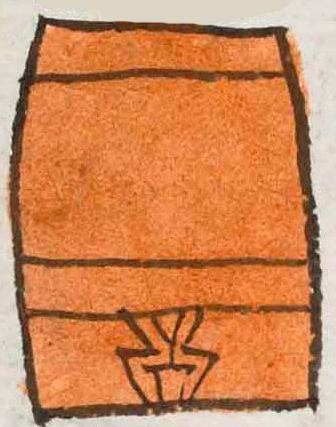huehuetl (Mdz24v)
This element has been carved from the compound sign for the place name, Ahuehuepan. The drum (huehuetl) color is orange, the color used in the Codex Mendoza for wood. It is vertical and somewhat barrel-shaped, with curves on the sides. The drum has three horizontal lines, one above the bulge and two below. The drum has a cutout at the bottom, which give the effect of legs. The shape of the cutout is geometrical. like mirrored zigzags.
Stephanie Wood
The huehuetl was constructed of boards set upright. It has a single membrane across the top, secured with a rope, but it could also be struck on the top edge (a higher pitch). See the Cantares Mexicanos (folio 7 recto) for information about how the huehuetl was played. The huehuetl drum was one of two especially well-known drums in pre-Hispanic and colonial times. Here is an image showing both a huehuetl and a teponaztli drum being played during a ritual, found in the Florentine Codex. The other (the teponaztli), pitched lower, was a horizontal, hollowed log with slits in the top in the shape of an H. Drums were played while people sang and danced, particularly at the time of festivals. In 1900, the anthropologist Frederick Starr wrote that the huehuetl was still being played during fiestas in Tlaxcala and Puebla. It has also played a role in a revival movement that started in the late 20th century.
Stephanie Wood
c. 1541, but by 1553 at the latest
Stephanie Wood
percussion, drums, atabales, huehuetes

huehue(tl), standing drum, upright drum, https://nahuatl.wired-humanities.org/content/huehuetl
upright cylindrical drum
el atabal or el tambor
Stephanie Wood
Codex Mendoza, folio 24 verso, https://digital.bodleian.ox.ac.uk/objects/2fea788e-2aa2-4f08-b6d9-648c00..., image 59 of 188.
The Bodleian Libraries, University of Oxford, hold the original manuscript, the MS. Arch. Selden. A. 1. This image is published here under the UK Creative Commons, “Attribution-NonCommercial-ShareAlike 3.0 License” (CC-BY-NC-SA 3.0).




